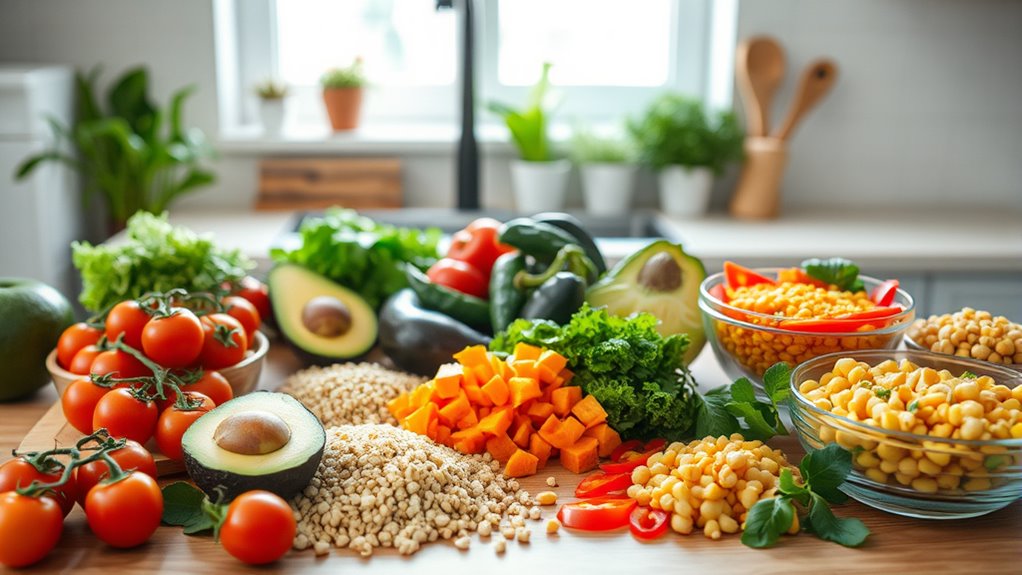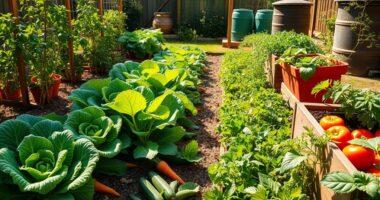To create balanced vegan meals, focus on combining plant-based proteins like beans, tofu, and lentils with colorful vegetables, fruits, and whole grains such as quinoa or brown rice. Plan your grocery list carefully and set aside time for batch cooking staples like grains and legumes. This approach saves time, reduces stress, and keeps your diet nutritious and varied. Keep exploring to discover more tips for making your vegan meal plan easy and effective.
Key Takeaways
- Focus on incorporating diverse plant-based proteins, vegetables, fruits, and whole grains to ensure balanced nutrition.
- Plan meals ahead by creating detailed grocery lists and batch-cooking staples like grains and legumes.
- Include colorful vegetables and fruits to boost nutrient intake and visual appeal of vegan meals.
- Dedicate specific times for meal prep to streamline cooking and reduce daily decision-making.
- Use versatile sauces and roasted vegetables to add flavor and variety to your vegan meals.

Have you ever wondered how some people manage to eat healthy and save time every week? The secret often lies in effective meal planning, especially when it comes to creating balanced vegan meals. When you take the time to plan ahead, you can streamline your grocery shopping, reduce last-minute decisions, and ensure your diet stays nutritious and diverse. One key step is meal prep—cooking or assembling your meals in advance so you’re not scrambling to put something together each day. This approach not only saves time but also helps you stick to your dietary goals. To start, creating a detailed grocery list is essential. This list should include all the ingredients you need for your planned meals, organized by sections of your grocery store to make shopping more efficient. When your grocery list is thorough, you’re less likely to forget key items, and you can avoid multiple trips or impulse buys.
As you plan your meals, focus on balancing your plate with plant-based proteins like beans, lentils, tofu, or tempeh. Incorporate a variety of colorful vegetables and fruits to ensure you’re getting a wide range of nutrients, and don’t forget whole grains such as quinoa, brown rice, or oats. When designing your meal prep sessions, consider batch-cooking staples like grains and legumes, which can be stored and used throughout the week. Preparing a big batch of roasted vegetables or a versatile sauce can also save you time and add flavor to multiple meals. Once you have your ingredients, set aside specific times during the week for meal prep, whether it’s Sunday afternoon or a few evenings. This way, you know exactly when to cook and assemble your dishes, making it easier to stay on track.
Having a clear plan in place means you’ll spend less time figuring out what to eat each day, and you’ll reduce the temptation to opt for less healthy options when hunger strikes. Plus, with a well-organized grocery list, your shopping trip becomes faster and more efficient, allowing you to spend more time enjoying your meals rather than stressing over what to buy. Incorporating meal prep techniques can help you maintain consistency and develop a sustainable routine. Consistency is key, and the more you practice meal prep and planning, the more natural it will become. Over time, you’ll develop a system that works for you, making healthy eating a seamless part of your weekly routine. In the end, thoughtful meal planning isn’t just about saving time; it’s about nourishing your body with balanced, delicious vegan meals that support your lifestyle.
Frequently Asked Questions
How Can I Ensure Sufficient Protein Intake on a Vegan Diet?
You can guarantee sufficient protein intake on a vegan diet by incorporating a variety of plant-based protein sources like beans, lentils, tofu, tempeh, nuts, seeds, and whole grains. Make sure to include these vegan protein sources in your meals regularly, combining different options to meet your daily protein needs. Staying consistent with diverse plant-based proteins helps you maintain a balanced diet and supports your overall health.
What Are Common Vegan Meal Prep Mistakes to Avoid?
You should avoid common vegan meal prep mistakes like neglecting proper cooking equipment and poor meal timing. Make sure you use the right tools, like sharp knives and non-stick pans, to prepare your meals efficiently. Also, plan your meal timing to prevent last-minute cooking stress and ensure freshness. By paying attention to equipment and scheduling, you’ll create balanced, delicious vegan meals without hassle or waste.
How Do I Incorporate Variety Into My Vegan Meal Plan?
Imagine you’re exploring international cuisines, like Thai or Mexican, to keep your vegan meals exciting. Incorporate seasonal produce for freshness and variety, such as summer berries or winter squash. Switch up grains, legumes, and veggies regularly, and try new recipes from different cultures. This approach prevents boredom, boosts nutrient intake, and keeps your meal plan fresh and flavorful. Embrace diversity to make vegan eating enjoyable and sustainable.
Are There Affordable Options for Vegan Superfoods?
Yes, you can find budget-friendly superfoods and affordable plant-based options easily. Look for staples like oats, lentils, and beans, which are nutrient-dense and cost-effective. Frozen berries and spinach are great for added vitamins without breaking the bank. Seeds like chia and flax are affordable superfoods packed with omega-3s. Shop sales, buy in bulk, and choose local produce to make these options even more budget-friendly.
How Can I Adapt Recipes for Food Allergies or Sensitivities?
Did you know that nearly 15 million Americans have food allergies? To adapt recipes for allergies or sensitivities, you can use allergy-friendly substitutions like coconut yogurt instead of dairy or flaxseed eggs for eggs. Don’t forget flavor enhancement tips—add herbs, spices, or citrus to boost taste without triggering allergies. This way, you enjoy delicious, safe vegan meals tailored to your needs and taste preferences.
Conclusion
Remember, Rome wasn’t built in a day, and mastering vegan meal planning takes time. Keep experimenting with new ingredients and flavors, and don’t get discouraged by setbacks. With patience and practice, you’ll create delicious, balanced meals that nourish your body and satisfy your taste buds. Stay committed, stay curious, and enjoy the journey toward a healthier, more sustainable lifestyle. Your perfect vegan meal is just around the corner—keep going!










